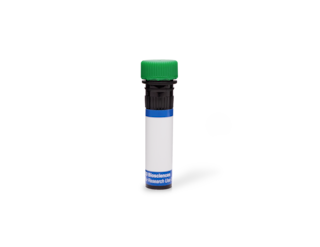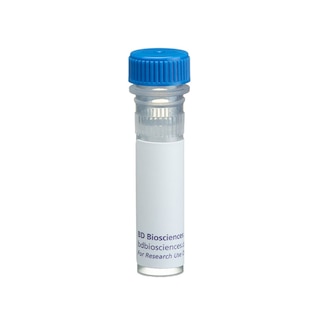-
Reagents
- Flow Cytometry Reagents
-
Western Blotting and Molecular Reagents
- Immunoassay Reagents
-
Single-Cell Multiomics Reagents
- BD® OMICS-Guard Sample Preservation Buffer
- BD® AbSeq Assay
- BD® Single-Cell Multiplexing Kit
- BD Rhapsody™ ATAC-Seq Assays
- BD Rhapsody™ Whole Transcriptome Analysis (WTA) Amplification Kit
- BD Rhapsody™ TCR/BCR Next Multiomic Assays
- BD Rhapsody™ Targeted mRNA Kits
- BD Rhapsody™ Accessory Kits
- BD® OMICS-One Protein Panels
-
Functional Assays
-
Microscopy and Imaging Reagents
-
Cell Preparation and Separation Reagents
Old Browser
This page has been recently translated and is available in French now.
Looks like you're visiting us from {countryName}.
Would you like to stay on the current location site or be switched to your location?
BD Transduction Laboratories™ Purified Mouse Anti-Caveolin 1
Clone C060 (RUO)

Left: Western blot analysis of Caveolin 1 on a human endothelial lysate. Lane 1: 1:500, lane 2: 1:1000, lane 3: 1:2000 dilution of the Caveolin 1 antibody.
Right: Immunofluorescent staining of HeLa (ATCC CCL-2) cells. Cells were seeded in a 96 well imaging plate (Cat. No. 353219) at ~ 10 000 cells per well. After overnight incubation, cells were stained using the Triton™ X-100 perm protocol and the anti-Caveolin 1 antibody. The second step reagent was FITC goat anti mouse Ig (Cat. No. 554001). Images were taken on a BD Pathway™ 855 bioimaging system using a 20x objective. This antibody also stained A549 (ATCC CCL-185) cells and worked with both the Triton™ X-100 and alcohol fix/perm protocols (see Recommended Assay Procedure). This antibody is not recommended for staining U-2 OS cells.

Left: Western blot analysis of Caveolin 1 on a human endothelial lysate. Lane 1: 1:500, lane 2: 1:1000, lane 3: 1:2000 dilution of the Caveolin 1 antibody.
Right: Immunofluorescent staining of HeLa (ATCC CCL-2) cells. Cells were seeded in a 96 well imaging plate (Cat. No. 353219) at ~ 10 000 cells per well. After overnight incubation, cells were stained using the Triton™ X-100 perm protocol and the anti-Caveolin 1 antibody. The second step reagent was FITC goat anti mouse Ig (Cat. No. 554001). Images were taken on a BD Pathway™ 855 bioimaging system using a 20x objective. This antibody also stained A549 (ATCC CCL-185) cells and worked with both the Triton™ X-100 and alcohol fix/perm protocols (see Recommended Assay Procedure). This antibody is not recommended for staining U-2 OS cells.



Left: Western blot analysis of Caveolin 1 on a human endothelial lysate. Lane 1: 1:500, lane 2: 1:1000, lane 3: 1:2000 dilution of the Caveolin 1 antibody.
Right: Immunofluorescent staining of HeLa (ATCC CCL-2) cells. Cells were seeded in a 96 well imaging plate (Cat. No. 353219) at ~ 10 000 cells per well. After overnight incubation, cells were stained using the Triton™ X-100 perm protocol and the anti-Caveolin 1 antibody. The second step reagent was FITC goat anti mouse Ig (Cat. No. 554001). Images were taken on a BD Pathway™ 855 bioimaging system using a 20x objective. This antibody also stained A549 (ATCC CCL-185) cells and worked with both the Triton™ X-100 and alcohol fix/perm protocols (see Recommended Assay Procedure). This antibody is not recommended for staining U-2 OS cells.
Left: Western blot analysis of Caveolin 1 on a human endothelial lysate. Lane 1: 1:500, lane 2: 1:1000, lane 3: 1:2000 dilution of the Caveolin 1 antibody.
Right: Immunofluorescent staining of HeLa (ATCC CCL-2) cells. Cells were seeded in a 96 well imaging plate (Cat. No. 353219) at ~ 10 000 cells per well. After overnight incubation, cells were stained using the Triton™ X-100 perm protocol and the anti-Caveolin 1 antibody. The second step reagent was FITC goat anti mouse Ig (Cat. No. 554001). Images were taken on a BD Pathway™ 855 bioimaging system using a 20x objective. This antibody also stained A549 (ATCC CCL-185) cells and worked with both the Triton™ X-100 and alcohol fix/perm protocols (see Recommended Assay Procedure). This antibody is not recommended for staining U-2 OS cells.

Left: Western blot analysis of Caveolin 1 on a human endothelial lysate. Lane 1: 1:500, lane 2: 1:1000, lane 3: 1:2000 dilution of the Caveolin 1 antibody.
Right: Immunofluorescent staining of HeLa (ATCC CCL-2) cells. Cells were seeded in a 96 well imaging plate (Cat. No. 353219) at ~ 10 000 cells per well. After overnight incubation, cells were stained using the Triton™ X-100 perm protocol and the anti-Caveolin 1 antibody. The second step reagent was FITC goat anti mouse Ig (Cat. No. 554001). Images were taken on a BD Pathway™ 855 bioimaging system using a 20x objective. This antibody also stained A549 (ATCC CCL-185) cells and worked with both the Triton™ X-100 and alcohol fix/perm protocols (see Recommended Assay Procedure). This antibody is not recommended for staining U-2 OS cells.

Left: Western blot analysis of Caveolin 1 on a human endothelial lysate. Lane 1: 1:500, lane 2: 1:1000, lane 3: 1:2000 dilution of the Caveolin 1 antibody.
Right: Immunofluorescent staining of HeLa (ATCC CCL-2) cells. Cells were seeded in a 96 well imaging plate (Cat. No. 353219) at ~ 10 000 cells per well. After overnight incubation, cells were stained using the Triton™ X-100 perm protocol and the anti-Caveolin 1 antibody. The second step reagent was FITC goat anti mouse Ig (Cat. No. 554001). Images were taken on a BD Pathway™ 855 bioimaging system using a 20x objective. This antibody also stained A549 (ATCC CCL-185) cells and worked with both the Triton™ X-100 and alcohol fix/perm protocols (see Recommended Assay Procedure). This antibody is not recommended for staining U-2 OS cells.




Regulatory Status Legend
Any use of products other than the permitted use without the express written authorization of Becton, Dickinson and Company is strictly prohibited.
Preparation And Storage
Recommended Assay Procedures
Bioimaging
1. Seed the cells in appropriate culture medium at ~10,000 cells per well in a BD Falcon™ 96-well Imaging Plate (Cat. No. 353219) and culture overnight.
2. Remove the culture medium from the wells, and fix the cells by adding 100 μl of BD Cytofix™ Fixation Buffer (Cat. No. 554655) to each well. Incubate for 10 minutes at room temperature (RT).
3. Remove the fixative from the wells, and permeabilize the cells using either BD Perm Buffer III, 90% methanol, or Triton™ X-100:
a. Add 100 μl of -20°C 90% methanol or Perm Buffer III (Cat. No. 558050) to each well and incubate for 5 minutes at RT.
OR
b. Add 100 μl of 0.1% Triton™ X-100 to each well and incubate for 5 minutes at RT.
4. Remove the permeabilization buffer, and wash the wells twice with 100 μl of 1× PBS.
5. Remove the PBS, and block the cells by adding 100 μl of BD Pharmingen™ Stain Buffer (FBS) (Cat. No. 554656) to each well. Incubate for 30 minutes at RT.
6. Remove the blocking buffer and add 50 μl of the optimally titrated primary antibody (diluted in Stain Buffer) to each well, and incubate for 1 hour at RT.
7. Remove the primary antibody, and wash the wells three times with 100 μl of 1× PBS.
8. Remove the PBS, and add the second step reagent at its optimally titrated concentration in 50 μl to each well, and incubate in the dark for 1 hour at RT.
9. Remove the second step reagent, and wash the wells three times with 100 μl of 1× PBS.
10. Remove the PBS, and counter-stain the nuclei by adding 200 μl per well of 2 μg/ml Hoechst 33342 (e.g., Sigma-Aldrich Cat. No. B2261) in 1× PBS to each well at least 15 minutes before imaging.
11. View and analyze the cells on an appropriate imaging instrument.
Bioimaging: For more detailed information please refer to http://www.bdbiosciences.com/support/resources/protocols/ceritifed_reagents.jsp
Western blot: For more detailed information please refer to http://www.bdbiosciences.com/support/resources/protocols/monoclonal_anti.jsp
Product Notices
- Since applications vary, each investigator should titrate the reagent to obtain optimal results.
- This antibody has been developed and certified for the bioimaging application. However, a routine bioimaging test is not performed on every lot. Researchers are encouraged to titrate the reagent for optimal performance.
- Triton is a trademark of the Dow Chemical Company.
- Source of all serum proteins is from USDA inspected abattoirs located in the United States.
- Caution: Sodium azide yields highly toxic hydrazoic acid under acidic conditions. Dilute azide compounds in running water before discarding to avoid accumulation of potentially explosive deposits in plumbing.
- Please refer to www.bdbiosciences.com/us/s/resources for technical protocols.
Companion Products






Identified as a tyrosine phosphorylated protein in Rous sarcoma virus-transformed chick embryo fibroblasts (CEF), caveolin is now known to be ubiquitously expressed. Caveolin (also known as VIP21) localizes to non-clathrin membrane invaginations (caveolae) on the inner surface of the plasma membrane. This transmembrane protein plays a structural role in these specializations. Caveolin is also present at the trans-Golgi network (TGN) and similar quantities are found in apically and basolaterally destined transport vesicles. Caveolin is part of a complex containing glycosylphosphatidylinositol (GPI)-linked molecules and cytoplasmic signaling proteins. Caveolin is a transmembrane adaptor molecule that can simultaneously recognize GPI-linked proteins and interact with downstream cytoplasmic signaling molecules, such as c-yes, Annexin II, and hetero-trimeric G proteins. Caveolin-1 can generate two forms, α and ß, due to alternate splicing of the mRNA. Caveolin-1 forms large lipid-binding homo-oligomers which are believed to play a role in caveolae formation. It may also function as a scaffolding protein which concentrates and organizes signaling molecules, a role supported by the fact that caveolin-1 interacts directly with inactive Ras and G-protein α subunits.
Development References (5)
-
Conrad PA, Smart EJ, Ying YS, Anderson RG, Bloom GS. Caveolin cycles between plasma membrane caveolae and the Golgi complex by microtubule-dependent and microtubule-independent steps. J Cell Biol. 1995; 131(1):1421-1433. (Biology). View Reference
-
Li S, Okamoto T, Chun M et al. Evidence for a regulated interaction between heterotrimeric G proteins and caveolin. J Biol Chem. 1995; 270(26):15693-15701. (Biology). View Reference
-
Peiro S, Comella JX, Enrich C, Martin-Zanca D, Rocamora N. PC12 cells have caveolae that contain TrkA. Caveolae-disrupting drugs inhibit nerve growth factor-induced, but not epidermal growth factor-induced, MAPK phosphorylation. J Biol Chem. 2000; 275(48):37846-37852. (Biology: Immunofluorescence). View Reference
-
Stan RV, Roberts WG, Predescu D, et al. Immunoisolation and partial characterization of endothelial plasmalemmal vesicles (caveolae). Mol Cell Biol. 1997; 8(4):595-605. (Biology: Electron microscopy). View Reference
-
de Weerd WF, Leeb-Lundberg LM. Bradykinin sequesters B2 bradykinin receptors and the receptor-coupled Galpha subunits Galphaq and Galphai in caveolae in DDT1 MF-2 smooth muscle cells. J Biol Chem. 1997; 272(28):17858-17866. (Biology: Immunofluorescence, Immunoprecipitation, Western blot). View Reference
Please refer to Support Documents for Quality Certificates
Global - Refer to manufacturer's instructions for use and related User Manuals and Technical data sheets before using this products as described
Comparisons, where applicable, are made against older BD Technology, manual methods or are general performance claims. Comparisons are not made against non-BD technologies, unless otherwise noted.
Please refer to Support Documents for Quality Certificates
Global - Refer to manufacturer's instructions for use and related User Manuals and Technical data sheets before using this products as described
Comparisons, where applicable, are made against older BD Technology, manual methods or are general performance claims. Comparisons are not made against non-BD technologies, unless otherwise noted.
For Research Use Only. Not for use in diagnostic or therapeutic procedures.